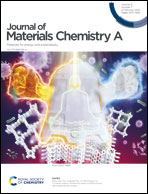Delicate crystallinity control enables high-efficiency P3HT organic photovoltaic cells†
Abstract
As a benchmark semiconducting polymer, poly(3-hexyl-thiophene) (P3HT) has been broadly used to construct a wide range of organic electronic devices such as photovoltaic cells, photodetectors, thermoelectrics, and transistors. In the last two decades, numerous studies have concentrated on modulating the morphology and performance of organic solar cells based on P3HT and fullerene derivatives. In comparison with P3HT:fullerene systems, the blends of P3HT with emerging nonfullerene acceptors remain significantly less explored and the structure–performance relationships are not well established. In this work, time-dependent grazing incidence X-ray scattering and real-space microscopy experiments were carried out to monitor the microstructure change of the high-efficiency blend of P3HT and a Y6-type nonfullerene acceptor (i.e., ZY-4Cl) over the duration of thermal annealing. By precisely manipulating the crystalline order of both the donor and acceptor, we found that simply shortening the annealing time can cause a remarkable 19-fold increase in the solar cell efficiency. We observed profound changes in all the photovoltaic parameters (open-circuit voltage, current density, fill factor, and power conversion efficiency) within the first 1 minute, while a slight variation emerged in the later stage. Attractively, the P3HT:ZY-4Cl blend film subject to thermal annealing for merely 30 seconds gave rise to a remarkable power conversion efficiency of ∼10.7%, which is the best efficiency of P3HT-based organic photovoltaic cells at present. The research shed light on the morphological optimization and cost-effective processing of polythiophene:nonfullerene blends for optoelectronic applications.

- This article is part of the themed collections: 2023 Journal of Materials Chemistry A Lunar New Year collection and 2022 Journal of Materials Chemistry A Most Popular Articles


 Please wait while we load your content...
Please wait while we load your content...